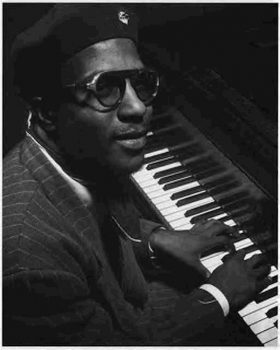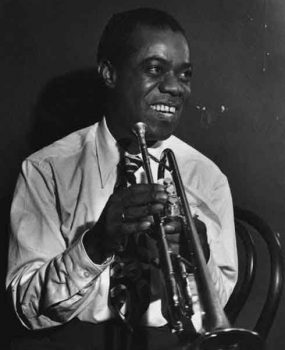“Music comes out of her. When she walks down the street, she leaves notes.” — Jimmy Rowles
Ella Fitzgerald
Ella Fitzgerald is considered one of the very best singer in the world. She is admired by her fans, young and old alike and she inspires her fellow artists and musicians. She performed at top venues all over the world. Her audiences were as diverse as her vocal range. They were rich and poor, made up of all races, all religions and all nationalities. In fact, many of them had just one binding factor in common – they all loved her.
Dubbed The First Lady of Song, Ella Fitzgerald was the most popular female jazz singer in the United States for more than half a century. In her lifetime, she won 13 Grammy awards and sold over 40 million albums.
Her voice was flexible, wide-ranging, accurate and ageless. She could sing sultry ballads, sweet jazz and imitate every instrument in an orchestra. She worked with all the jazz greats, from Duke Ellington, Count Basie and Nat King Cole, to Frank Sinatra, Dizzy Gillespie and Benny Goodman.
Nat King Cole and Ella Fitzgerald sing Cole Porter
She toured all over the world, sometimes performing two shows a day in cities hundreds of miles apart. In 1974, Ella spent a legendary two weeks performing in New York with Frank Sinatra and Count Basie. She was inducted into the Down Beat magazine Hall of Fame, and received Kennedy Center Honors for her continuing contributions to the arts. 1958 the first Grammy awards were held and Ella Fitzgerald won Best Female Vocal Performance for The Irving Berlin Songbook (album) and Best Individual Jazz Performance for The Duke Ellington Songbook (album) 1959 Grammy awards, Best Female Vocal Performance for But Not For Me and Best Individual Jazz Performance for Ella Swings Lightly.
Ella Jane Fitzgerald was born in Newport News, Va. on April 25, 1917. Her father, William, and mother, Temperance (Tempie), parted ways shortly after her birth. Together, Tempie and Ella went to Yonkers, N.Y, where they eventually moved in with Tempie’s longtime boyfriend Joseph Da Silva. Ella’s half-sister, Frances, was born in 1923 and soon she began referring to Joe as her stepfather. Their apartment was in a mixed neighborhood, where Ella made friends easily. She considered herself more of a tomboy, and often joined in the neighborhood games of baseball. Sports aside, she enjoyed dancing and singing with her friends, and some evenings they would take the train into Harlem and watch various acts at the Apollo Theater.
In 1934 Ella’s name was pulled in a weekly drawing at the Apollo and she won the opportunity to compete in Amateur Night. Ella went to the theater that night planning to dance, but when the frenzied Edwards Sisters closed the main show, Ella changed her mind. “They were the dancingest sisters around,” Ella said, and she felt her act would not compare. Once on stage, faced with boos and murmurs of “What’s she going to do?” from the rowdy crowd, a scared and disheveled Ella made the last minute decision to sing. She asked the band to play Hoagy Carmichael’s Judy, a song she knew well because Connee Boswell’s rendition of it was among Tempie’s favorites. Ella quickly quieted the audience, and by the song’s end they were demanding an encore. She obliged and sang the flip side of the Boswell Sister’s record, The Object of My Affections. Off stage, and away from people she knew well, Ella was shy and reserved. She was self-conscious about her appearance, and for a while even doubted the extent of her abilities. On stage, however, Ella was surprised to find she had no fear. She felt at home in the spotlight. “Once up there, I felt the acceptance and love from my audience,” Ella said. “I knew I wanted to sing before people the rest of my life.” In the band that night was saxophonist and arranger Benny Carter. Impressed with her natural talent, he began introducing Ella to people who could help launch her career. In the process he and Ella became lifelong friends, often working together.
In January 1935 she won the chance to perform for a week with the Tiny Bradshaw band at the Harlem Opera House. It was there that Ella first met drummer and bandleader Chick Webb. Although her voice impressed him, Chick had already hired male singer Charlie Linton for the band. He offered Ella the opportunity to test with his band when they played a dance at Yale University. If the kids like her she can stay, Chick announced.
Shortly afterward, Ella began singing a rendition of the song, (If You Can’t Sing It) You Have to Swing It. During this time, the era of big swing bands was shifting, and the focus was turning more toward bebop. Ella played with the new style, often using her voice to take on the role of another horn in the band. You Have to Swing It was one of the first times she began experimenting with scat singing, and her improvisation and vocalization thrilled fans. Throughout her career, Ella would master scat singing, turning it into a form of art. In 1938, at the age of 21, Ella recorded a playful version of the nursery rhyme, A-Tisket, A-Tasket. The album sold 1 million copies, hit number one, and stayed on the pop charts for 17 weeks. On June 16, 1939, Ella mourned the loss of her mentor Chick Webb. In his absence the band was renamed Ella Fitzgerald and Her Famous Band, and she took on the overwhelming task of bandleader.
Ella Fitzgerald sings April in Paris with her husband Ray Brown on bass
While on tour with Dizzy Gillespie’s band in 1946, Ella fell in love with bassist Ray Brown. The two were married and eventually adopted a son, whom they named Ray, Jr. At the time, Ray was working for producer and manager Norman Granz on the “Jazz at the Philharmonic” tour. Norman saw that Ella had what it took to be an international star, and he convinced Ella to sign with him. It was the beginning of a lifelong business relationship and friendship.
Under Norman’s management, Ella joined the Philharmonic tour, worked with Louis Armstrong on several albums and began producing her infamous songbook series. From 1956-1964, she recorded covers of other musicians’ albums, including those by Cole Porter, Duke Ellington, the Gershwins, Johnny Mercer, Irving Berlin, and Rodgers and Hart. The series was wildly popular, both with Ella’s fans and the artists she covered.
“I never knew how good our songs were until I heard Ella Fitzgerald sing them,” Ira Gershwin
Ella Fitzgerald on the Dean Martin Show
Ella also began appearing on television variety shows. She quickly became a favorite and frequent guest on numerous programs, including “The Bing Crosby Show,” “The Dinah Shore Show,” “The Frank Sinatra Show,” “The Ed Sullivan Show,” “The Tonight Show,” “The Nat King Cole Show,” “The Andy Willams Show” and “The Dean Martin Show.”
Ella Fitzgerald received so many awards that they are too numerous to mention in this article, some of the highlights which included:
• 13 Grammy awards
• A-Tisket, A-Tasket entered into the Grammy Hall of Fame
• Kennedy Center for Performing Arts’ Medal of Honor Award
• The Recording Academy Lifetime Achievement Award
• Pied Piper Award
• American Society of Composers
• Women at Work organization’s Bicentennial Woman
• Authors and Publishers’ highest honor
• George And Ira Gershwin Award for Outstanding Achievement
• National Medal of Art
• Honorary chairmanship of the Martin Luther King Foundation
• Received first ASCAP award in recognition of an artist
• Honorary doctorate degrees from Dartmouth, Talladega, Howard and Yale Universities
• Peabody Award for Outstanding Contributions in Music
• The first Society of Singers Lifetime Achievement Award, named “Ella” in her honor
• NAACP Award for lifetime achievement
Ella continued to work as hard as she had early on in her career, despite the ill effects on her health. She toured all over the world, sometimes performing two shows a day in cities hundreds of miles apart. In 1974, Ella spent a legendary two weeks performing in New York with Frank Sinatra and Count Basie. Still going strong five years later, she was inducted into the Down Beat magazine Hall of Fame, and received Kennedy Center Honors for her continuing contributions to the arts.
Outside of the arts, Ella had a deep concern for child welfare. Though this aspect of her life was rarely publicized, she frequently made generous donations to organizations for disadvantaged youths, and the continuation of these contributions was part of the driving force that prevented her from slowing down.
To learn more or to watch a few videos about Ella Fitzgerald major performances visit: www.ellafitzgerald.com
Ella Fitzgerald started a non-profit organization in 1993 that is still going strong. http://www.ellafitzgeraldfoundation.org/news.html



